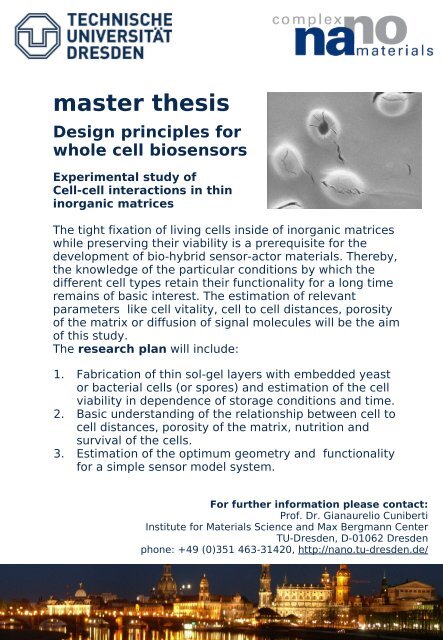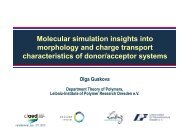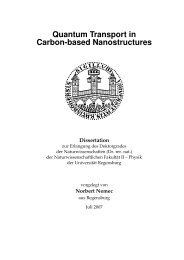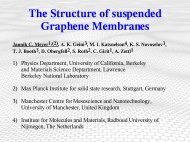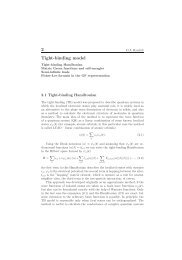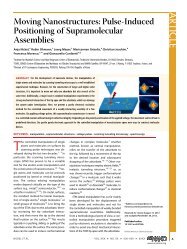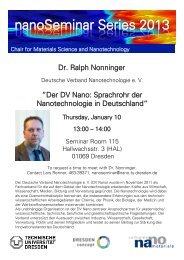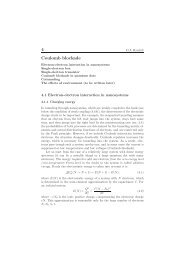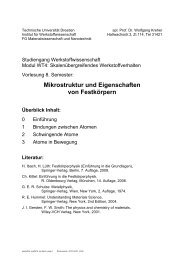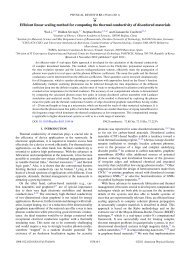master thesis - Chair of Materials Science and Nanotechnology
master thesis - Chair of Materials Science and Nanotechnology
master thesis - Chair of Materials Science and Nanotechnology
Create successful ePaper yourself
Turn your PDF publications into a flip-book with our unique Google optimized e-Paper software.
<strong>master</strong> <strong>thesis</strong><br />
Design principles for<br />
whole cell biosensors<br />
Experimental study <strong>of</strong><br />
Cell-cell interactions in thin<br />
inorganic matrices<br />
The tight fixation <strong>of</strong> living cells inside <strong>of</strong> inorganic matrices<br />
while preserving their viability is a prerequisite for the<br />
development <strong>of</strong> bio-hybrid sensor-actor materials. Thereby,<br />
the knowledge <strong>of</strong> the particular conditions by which the<br />
different cell types retain their functionality for a long time<br />
remains <strong>of</strong> basic interest. The estimation <strong>of</strong> relevant<br />
parameters like cell vitality, cell to cell distances, porosity<br />
<strong>of</strong> the matrix or diffusion <strong>of</strong> signal molecules will be the aim<br />
<strong>of</strong> this study.<br />
The research plan will include:<br />
1. Fabrication <strong>of</strong> thin sol-gel layers with embedded yeast<br />
or bacterial cells (or spores) <strong>and</strong> estimation <strong>of</strong> the cell<br />
viability in dependence <strong>of</strong> storage conditions <strong>and</strong> time.<br />
2. Basic underst<strong>and</strong>ing <strong>of</strong> the relationship between cell to<br />
cell distances, porosity <strong>of</strong> the matrix, nutrition <strong>and</strong><br />
survival <strong>of</strong> the cells.<br />
3. Estimation <strong>of</strong> the optimum geometry <strong>and</strong> functionality<br />
for a simple sensor model system.<br />
For further information please contact:<br />
Pr<strong>of</strong>. Dr. Gianaurelio Cuniberti<br />
Institute for <strong>Materials</strong> <strong>Science</strong> <strong>and</strong> Max Bergmann Center<br />
TU-Dresden, D-01062 Dresden<br />
phone: +49 (0)351 463-31420, http://nano.tu-dresden.de/
<strong>master</strong> <strong>thesis</strong><br />
Pyroelectric<br />
disinfection<br />
<strong>of</strong> bacteria cells<br />
Experimental study <strong>of</strong><br />
disinfection <strong>of</strong> pyroelectric<br />
composite materials<br />
<strong>Materials</strong> which are pyroelectric show the ability to generate<br />
a temporary electric potential by heating or cooling them.<br />
The electric potential inhibits the growth <strong>of</strong> microorganisms<br />
such as bacteria, fungi, algae or it can even kill them.<br />
Immobilized into filters or onto carriers, these crystals are<br />
applicable as disinfection tool e.g. in drinking water tanks,<br />
swimmingpools, or on labbenches.<br />
The research plan will include:<br />
1. Immobilization <strong>of</strong> pyroelectric crystal powder (LiNbO 3 ,<br />
LiTaO 3 ) on organic matrices (e. g. alginate, collagen) in<br />
order to create porous pyroelectric filter material<br />
2. Investigation <strong>of</strong> the pyroelectric properties <strong>of</strong> this<br />
composite material depending on particle size <strong>of</strong><br />
pyroelectric powder<br />
3. Testing the pyroelectric filter due to the effect <strong>of</strong><br />
disinfection<br />
For further information please contact:<br />
Pr<strong>of</strong>. Dr. Gianaurelio Cuniberti<br />
Institute for <strong>Materials</strong> <strong>Science</strong> <strong>and</strong> Max Bergmann Center<br />
TU-Dresden, D-01062 Dresden<br />
phone: +49 (0)351 463-31420, http://nano.tu-dresden.de/
<strong>master</strong> <strong>thesis</strong><br />
Manipulation <strong>of</strong> organic<br />
molecules by LT-STM<br />
Experimental study <strong>of</strong><br />
organic molecules by Scanning<br />
Tunneling Microscope (STM)<br />
at low temperature<br />
Experimental STM images <strong>of</strong> PTCDA<br />
(R. Temirov et al., New J. Phys. 10, 053012<br />
(2008))<br />
Low Temperature STM (LT-STM) allows the manipulation <strong>of</strong><br />
atoms <strong>and</strong> molecules. Experiments permit a deeper insight<br />
into the quantum electronics <strong>of</strong> molecular systems <strong>and</strong><br />
provide important information on the conformational <strong>and</strong><br />
mechanical properties <strong>of</strong> single complex molecules. The<br />
present project will be centred on the manipulation <strong>of</strong><br />
individual molecules to quantitatively characterize the<br />
charge transport through a molecular unit.<br />
The research plan will include:<br />
1. Basic underst<strong>and</strong>ing <strong>of</strong> the electronic <strong>and</strong> structural<br />
properties <strong>of</strong> the relevant metallic surfaces <strong>and</strong><br />
organic molecules<br />
2. Basic underst<strong>and</strong>ing <strong>of</strong> Ultra-High-Vacuum (UHV) <strong>and</strong><br />
Scanning Tunneling Microscopy<br />
3. Probe preparation in UHV <strong>and</strong> molecular deposition<br />
4. Imaging <strong>and</strong> manipulation <strong>of</strong> single molecules on<br />
metallic surfaces.<br />
For further information please contact:<br />
Pr<strong>of</strong>. Dr. Gianaurelio Cuniberti<br />
Institute for <strong>Materials</strong> <strong>Science</strong> <strong>and</strong> Max Bergmann Center<br />
TU-Dresden, D-01062 Dresden<br />
phone: +49 (0)351 463-31420, http://nano.tu-dresden.de/
<strong>master</strong> <strong>thesis</strong><br />
Metallo-organic<br />
nanostructures<br />
Theoretical study <strong>of</strong> Scanning<br />
Tunneling Microscope (STM)<br />
experiments on organic molecules:<br />
a density functional theory approach<br />
Goal <strong>of</strong> this <strong>thesis</strong> will be the investigation<br />
<strong>of</strong> the binding, <strong>and</strong> simulation <strong>of</strong> STM images,<br />
<strong>of</strong> organic molecules (PTCDA, fullerenes,<br />
phthalocyanines, organic photodiodes,<br />
etc.) on metallic surfaces.<br />
The research plan will include:<br />
PTCDA on Ag (111), with image <strong>of</strong><br />
LDOS <strong>of</strong> LUMO (as would be<br />
observed in STM)<br />
1. Basic underst<strong>and</strong>ing <strong>of</strong> the electronic <strong>and</strong> structural<br />
properties <strong>of</strong> the relevant metallic surfaces <strong>and</strong><br />
organic molecules<br />
2. Perform geometry optimizations <strong>of</strong> the the molecules<br />
chemisorbed (bonded) to metallic surfaces<br />
3. Calculate DOS <strong>and</strong> simulate STM images using DFT<br />
combined with Ters<strong>of</strong>f-Hamann approximation<br />
4. Investigate possible switching mechanisms for<br />
nanoelectronic devices formed from these structures<br />
For further information please contact:<br />
Pr<strong>of</strong>. Dr. Gianaurelio Cuniberti<br />
Institute for <strong>Materials</strong> <strong>Science</strong> <strong>and</strong> Max Bergmann Center<br />
TU-Dresden, D-01062 Dresden<br />
phone: +49 (0)351 463-31420, http://nano.tu-dresden.de/
<strong>master</strong> <strong>thesis</strong><br />
Transport properties<br />
<strong>of</strong> molecular switches<br />
One <strong>of</strong> the main challenges<br />
<strong>of</strong> the research within the<br />
realm <strong>of</strong> nanoscience <strong>and</strong><br />
nanotechnology is the ability<br />
to control conformations at<br />
the molecular scale. One typical example are molecular<br />
switches, where the conformation <strong>of</strong> the molecule can be<br />
modified by light irradiation or mechanical actions. Goals <strong>of</strong><br />
the <strong>thesis</strong> are the study <strong>of</strong> the transport properties <strong>of</strong> such<br />
switches.<br />
The research plan will include:<br />
1. Becoming familiar with the applications <strong>of</strong> molecular<br />
switches in nanoelectronics<br />
2. Learning the basics <strong>of</strong> density functional tight binding<br />
calculations for the electronic structure<br />
3. Learning the basics <strong>of</strong> quantum transport<br />
3. Computing charge transport through molecular switches<br />
in different conformations<br />
For further information please contact:<br />
Pr<strong>of</strong>. Dr. Gianaurelio Cuniberti<br />
Institute for <strong>Materials</strong> <strong>Science</strong> <strong>and</strong> Max Bergmann Center<br />
TU-Dresden, D-01062 Dresden<br />
phone: +49 (0)351 463-31420, http://nano.tu-dresden.de/
<strong>master</strong> <strong>thesis</strong><br />
Controlling the electrical<br />
properties <strong>of</strong> nanoscale<br />
field-effect transistors<br />
The size in electronic components<br />
such as transistors <strong>and</strong> capacitors<br />
is reducing down to the scale<br />
(around 10nm) where quantum<br />
effects become significant. At this<br />
lengthscale conventional models <strong>of</strong> continuous media don’t<br />
work anymore. Thus for the further development <strong>of</strong> electronic<br />
devices, the underst<strong>and</strong>ing <strong>of</strong> charge transport at the<br />
atomic scale including quantum effects is required. For this<br />
purpose, electronic devices such as field effect transistors<br />
(FETs) are modeled <strong>and</strong> the charge transport through the<br />
devices is investigated using atomistic descriptions.<br />
The research plan will include:<br />
1. Modeling <strong>and</strong> relaxation <strong>of</strong> FET devices.<br />
2. Calculation <strong>of</strong> electronic properties <strong>of</strong> FET devices in<br />
tight-binding model.<br />
3. Simulation <strong>of</strong> I-V characteristics with different gate<br />
voltages using quantum transport theory within the<br />
Green function formalism.<br />
4. Investigation <strong>of</strong> the homogeneous <strong>and</strong> inhomogeneous<br />
gate field effect on the transport properties.<br />
5. Investigation <strong>of</strong> the influence <strong>of</strong> impurities, surface<br />
roughness, the shape <strong>of</strong> the devices, <strong>and</strong> surface<br />
modifications on I-V characteristics.<br />
For further information please contact:<br />
Pr<strong>of</strong>. Dr. Gianaurelio Cuniberti<br />
Institute for <strong>Materials</strong> <strong>Science</strong> <strong>and</strong> Max Bergmann Center<br />
TU-Dresden, D-01062 Dresden<br />
phone: +49 (0)351 463-31420, http://nano.tu-dresden.de/
<strong>master</strong> <strong>thesis</strong><br />
Underst<strong>and</strong>ing mutations<br />
The conformational dynamics in<br />
bio-molecular systems (DNA, proteins,<br />
etc) can play an important role in<br />
promoting or hindering electron or hole<br />
propagation through such systems.<br />
This is a crucial issue since e.g. DNA<br />
damage repair occurs via electron<br />
transfer processes. It is thus <strong>of</strong><br />
interest to investigate the propagation<br />
properties <strong>of</strong> a charge injected into a<br />
fluctuating bio-molecule. In this <strong>thesis</strong> we<br />
will study model systems able to mimic<br />
such dynamical processes.<br />
The research plan will include:<br />
1. Becoming familiar electron transfer in DNA oligomers<br />
2. Learning how to solve the time-dependent Schrödinger<br />
equation with static potentials.<br />
3. Extend this to the case <strong>of</strong> time dependent fluctuating<br />
potentials to mimic the DNA conformational dynamics<br />
4. Study the case <strong>of</strong> a linear chain where the fluctuations <strong>of</strong><br />
the electronic parameters are drawn from molecular<br />
dynamics simulations.<br />
For further information please contact:<br />
Pr<strong>of</strong>. Dr. Gianaurelio Cuniberti<br />
Institute for <strong>Materials</strong> <strong>Science</strong> <strong>and</strong> Max Bergmann Center<br />
TU-Dresden, D-01062 Dresden<br />
phone: +49 (0)351 463-31420, http://nano.tu-dresden.de/
<strong>master</strong> <strong>thesis</strong><br />
Boron Nanostructures<br />
Theoretical study <strong>of</strong><br />
physical properties <strong>of</strong><br />
boron nanostructures<br />
Nanomaterials are in the focus <strong>of</strong> research worldwide. A<br />
new <strong>and</strong> very promising class <strong>of</strong> materials are boron<br />
nanostructures in form <strong>of</strong> sheets, nanotubes, fullerenes,<br />
nanowires, nanoribons, etc. Many <strong>of</strong> their properties still<br />
need to be determined. The goal <strong>of</strong> this <strong>thesis</strong> is to study<br />
the physical properties <strong>of</strong> boron nanotubes by means <strong>of</strong><br />
theory. Your results will provide important information<br />
used to identify boron nanostructures in the lab.<br />
The research plan will include:<br />
1. Learning the basics <strong>of</strong> carbon <strong>and</strong> boron nanostructures<br />
2. Learning the basics <strong>of</strong> density functional theory (DFT).<br />
3. Get introduced to the operation <strong>of</strong> a DFT code<br />
(SIESTA, VASP, DFTB).<br />
4. Performing DFT calculations <strong>of</strong> boron nanostructures<br />
to determine their basic electronic properties.<br />
5. Study vibrational, optical or transport properties<br />
For further information please contact:<br />
Pr<strong>of</strong>. Dr. Gianaurelio Cuniberti<br />
Institute for <strong>Materials</strong> <strong>Science</strong> <strong>and</strong> Max Bergmann Center<br />
TU-Dresden, D-01062 Dresden<br />
phone: +49 (0)351 463-31420, http://nano.tu-dresden.de/
<strong>master</strong> <strong>thesis</strong><br />
Organic electronic materials<br />
Theoretical study <strong>of</strong> the structureproperty<br />
relation <strong>of</strong> molecular<br />
organic semiconductors<br />
Converting sun light into electricity<br />
with thin film organic semiconductors<br />
is receiving increased interest by<br />
the industrial sector at the moment.<br />
In organic electronic devices, various conjugated molecules<br />
such as polycyclic aromatic hydrocarbons: tetracene,<br />
pentacene; oligothiophenes <strong>and</strong> their derivatives are used to<br />
build the transport layers <strong>and</strong> organic dyes for the absorber<br />
layers. The most important characteristic <strong>of</strong> the molecular<br />
semiconductors is the charge carrier mobility.<br />
Theory is expected to play a major role in the underst<strong>and</strong>ing<br />
<strong>of</strong> the structure-property relationship with respect to the<br />
mobility. The goal <strong>of</strong> this <strong>thesis</strong> is the theoretical<br />
investigation <strong>of</strong> charge transport parameters <strong>of</strong> different<br />
experimentally studied organic molecular semiconductors.<br />
The research plan will include:<br />
1. Learning the fundamentals <strong>of</strong> molecular dynamics<br />
simulations <strong>and</strong> ab initio calculations.<br />
2. Modeling thin films <strong>of</strong> different classes <strong>of</strong> organic<br />
functional materials.<br />
3. Calculation <strong>of</strong> charge transport parameters <strong>and</strong><br />
the charge carrier mobility with different techniques.<br />
For further information please contact:<br />
Pr<strong>of</strong>. Dr. Gianaurelio Cuniberti<br />
Institute for <strong>Materials</strong> <strong>Science</strong> <strong>and</strong> Max Bergmann Center<br />
TU-Dresden, D-01062 Dresden<br />
phone: +49 (0)351 463-31420, http://nano.tu-dresden.de/
<strong>master</strong> <strong>thesis</strong><br />
Efficient energy conversion<br />
at the molecular level<br />
theoretical study <strong>of</strong> thermoelectric<br />
figure <strong>of</strong> merit <strong>of</strong> molecular junctions<br />
Inspired by the recent developments in<br />
molecular electronics, which is involved<br />
in underst<strong>and</strong>ing charge transport<br />
properties <strong>of</strong> molecular systems, thermoelectric properties<br />
<strong>of</strong> molecular systems is now becoming a focus <strong>of</strong><br />
nanoscience. Pioneering experiments show that molecular<br />
junctions can give large values <strong>of</strong> thermoelectric figure <strong>of</strong><br />
merit, so they can be used as efficient energy conversion<br />
devices. The goal <strong>of</strong> this <strong>thesis</strong> will be theoretical<br />
investigation <strong>of</strong> thermal as well as charge transport at the<br />
quantum level, <strong>and</strong> exploring the material dependent<br />
properties that influence the conversion efficiency.<br />
The research plan will include:<br />
1. Basics <strong>of</strong> modeling electronic <strong>and</strong> vibrational properties <strong>of</strong><br />
nano-scale systems.<br />
2. Getting introduced to quantum transport theory <strong>and</strong><br />
becoming familiar with Green function techniques.<br />
3. Inclusion <strong>of</strong> impurity <strong>and</strong> surface roughness effects <strong>and</strong><br />
the influence <strong>of</strong> geometrical modulations.<br />
4. Investigation <strong>of</strong> methods to increase the thermoelectric<br />
figure <strong>of</strong> merit at molecular junctions.<br />
For further information please contact:<br />
Pr<strong>of</strong>. Dr. Gianaurelio Cuniberti<br />
Institute for <strong>Materials</strong> <strong>Science</strong> <strong>and</strong> Max Bergmann Center<br />
TU-Dresden, D-01062 Dresden<br />
phone: +49 (0)351 463-31420, http://nano.tu-dresden.de/
<strong>master</strong> <strong>thesis</strong><br />
Modeling fuel cells<br />
theoretical study <strong>of</strong> the adsorption <strong>of</strong><br />
water on platinum oxides<br />
Interaction <strong>of</strong> water with platinum oxides is <strong>of</strong> great interest in<br />
many respects as e.g. in fuel cells, in vehicle exhaust catalysts,<br />
<strong>and</strong> for assessment <strong>of</strong> consequences due to environmental<br />
pollution by platinum. Nanosized platinum clusters are covered by<br />
a thin oxide layer. Interaction <strong>of</strong> those clusters in wet<br />
environment could lead to dissolution <strong>of</strong> platinum <strong>and</strong> formation<br />
<strong>of</strong> undesired platinum complexes. For a basic atomistic<br />
underst<strong>and</strong>ing <strong>of</strong> this process, the interaction <strong>of</strong> water molecules<br />
with platinum oxides has to be clarified. In a first step, adsorption<br />
mechanisms <strong>of</strong> water on platinum oxides shall be elucidated by<br />
density-functional calculations.<br />
The research plan will include:<br />
1. Becoming familiar with ab initio calculations <strong>of</strong> atomic<br />
structures by means <strong>of</strong> density-functional theory.<br />
2. Total energy calculations with structure relaxation for<br />
different positions <strong>of</strong> water adsorbed on oxidized platinum<br />
surfaces.<br />
3. Investigation <strong>of</strong> the adsorption pathways <strong>and</strong> the associated<br />
energy pr<strong>of</strong>iles <strong>of</strong> water molecules on reactive surface sites<br />
determined in 2).<br />
4. Investigation <strong>of</strong> the effect <strong>of</strong> the water coverage (from single<br />
molecules to liquid water) on the adsorption mechanisms in 3).<br />
For further information please contact:<br />
Pr<strong>of</strong>. Dr. Gianaurelio Cuniberti<br />
Institute for <strong>Materials</strong> <strong>Science</strong> <strong>and</strong> Max Bergmann Center<br />
TU-Dresden, D-01062 Dresden<br />
phone: +49 (0)351 463-31420, http://nano.tu-dresden.de/


